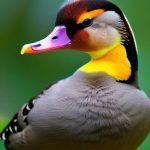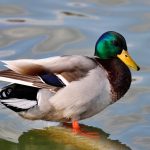Black and white duck breeds are a popular choice among duck enthusiasts for their striking and unique appearance. These breeds are known for their beautiful plumage, which often features a combination of black and white feathers that create a visually stunning contrast. Black and white ducks are also prized for their friendly and docile nature, making them a great addition to any backyard flock or farm. In this article, we will explore the characteristics, popular breeds, care and maintenance, breeding and reproduction, as well as the uses and purposes of black and white duck breeds.
Table of Contents
- 1 Characteristics of Black and White Duck Breeds
- 2 Popular Black and White Duck Breeds
- 3 Care and Maintenance of Black and White Duck Breeds
- 4 Breeding and Reproduction of Black and White Duck Breeds
- 5 Uses and Purposes of Black and White Duck Breeds
- 6 Conclusion and Final Thoughts on Black and White Duck Breeds
- 7 FAQs
Key Takeaways
- Black and white duck breeds are popular for their unique and striking appearance, making them a favorite among duck enthusiasts.
- These duck breeds are known for their hardiness, adaptability, and calm temperament, making them suitable for both backyard and commercial farming.
- Some popular black and white duck breeds include the Magpie, Cayuga, and Ancona, each with their own distinct characteristics and qualities.
- Proper care and maintenance of black and white duck breeds include providing a balanced diet, clean water, shelter, and regular health check-ups to ensure their well-being.
- Breeding and reproduction of black and white duck breeds require careful selection of breeding stock, proper nesting areas, and monitoring of the breeding process to ensure successful hatching and healthy ducklings.
Characteristics of Black and White Duck Breeds
Black and white duck breeds are known for their distinctive coloration, with some breeds featuring solid black or white plumage, while others have a combination of both colors in intricate patterns. These ducks often have a medium-sized body with a slightly elongated neck and a rounded head. Their bills are typically a dark color, which complements their overall appearance. In terms of temperament, black and white duck breeds are generally known to be friendly, sociable, and easy to handle, making them a popular choice for both novice and experienced duck owners. Additionally, these breeds are known for their hardy nature and adaptability to various climates, making them suitable for a wide range of environments.
Black and white duck breeds are also valued for their excellent foraging abilities, as they are adept at finding their own food in natural settings. They are also known for their strong maternal instincts, making them good mothers when it comes to hatching and raising ducklings. Overall, black and white duck breeds are prized for their striking appearance, friendly disposition, and adaptability, making them a popular choice for both ornamental and practical purposes.
Popular Black and White Duck Breeds
There are several popular black and white duck breeds that are favored by duck enthusiasts for their unique characteristics and striking appearance. One of the most well-known breeds is the Magpie duck, which features a distinctive black and white pied plumage that sets it apart from other duck breeds. Magpie ducks are known for their friendly nature and excellent egg-laying abilities, making them a popular choice for backyard flocks and small farms. Another popular black and white duck breed is the Cayuga duck, which is known for its iridescent greenish-black plumage that shimmers in the sunlight. Cayuga ducks are prized for their calm temperament and excellent foraging abilities, making them a great choice for free-range environments.
The Welsh Harlequin is another popular black and white duck breed that is prized for its striking silver and white plumage. This breed is known for its friendly disposition and excellent egg-laying abilities, making it a popular choice for both ornamental and practical purposes. Other popular black and white duck breeds include the Ancona, Swedish Black, and Silver Appleyard, all of which are valued for their unique coloration, friendly nature, and excellent egg-laying abilities. Overall, these breeds are prized for their striking appearance and practical qualities, making them a popular choice for duck enthusiasts around the world.
Care and Maintenance of Black and White Duck Breeds
When it comes to caring for black and white duck breeds, there are several important factors to consider to ensure their health and well-being. Providing a suitable living environment is essential, as these ducks require access to clean water for swimming and bathing, as well as shelter from predators and inclement weather. Additionally, providing a balanced diet that includes a mix of commercial duck feed, fresh greens, and access to insects and other natural foods is important to ensure their nutritional needs are met.
Regular health checks are also important to monitor the overall well-being of black and white duck breeds, including checking for signs of illness or injury, as well as providing routine vaccinations and parasite control. Proper grooming is also essential, including regular feather maintenance to keep their plumage in good condition. Finally, providing opportunities for exercise and mental stimulation is important to ensure their overall health and well-being.
Breeding and Reproduction of Black and White Duck Breeds
Breeding black and white duck breeds requires careful planning and consideration to ensure successful reproduction. Selecting healthy breeding stock with desirable traits is essential to produce high-quality offspring with the desired coloration and characteristics. Providing suitable nesting areas with access to clean bedding materials is important to encourage natural breeding behaviors. Additionally, providing proper nutrition and access to clean water is essential to support the health of breeding ducks and ensure successful reproduction.
Monitoring the breeding process is important to ensure successful hatching and raising of ducklings. Providing suitable brooding areas with access to heat lamps or other heating sources is important to ensure the health and well-being of young ducklings. Additionally, providing proper nutrition and access to clean water is essential to support the growth and development of young ducklings. Overall, successful breeding and reproduction of black and white duck breeds requires careful planning, attention to detail, and proper care to ensure the health and well-being of both breeding ducks and their offspring.
Uses and Purposes of Black and White Duck Breeds

Black and white duck breeds serve a variety of purposes in both ornamental and practical settings. Their striking appearance makes them a popular choice for ornamental purposes, including as exhibition birds in poultry shows or as decorative additions to ponds or water features. Additionally, their friendly nature makes them a popular choice for backyard flocks or small farms, where they can provide entertainment and companionship.
In practical settings, black and white duck breeds are valued for their excellent egg-laying abilities, with some breeds known to produce a high number of eggs throughout the year. Their adaptability to various climates makes them suitable for a wide range of environments, making them a versatile choice for small-scale egg production. Additionally, their excellent foraging abilities make them well-suited for free-range environments, where they can help control pests and provide natural fertilizer for gardens or agricultural fields.
Overall, black and white duck breeds serve a variety of uses and purposes in both ornamental and practical settings, making them a popular choice for duck enthusiasts around the world.
Conclusion and Final Thoughts on Black and White Duck Breeds
In conclusion, black and white duck breeds are prized for their striking appearance, friendly nature, adaptability, and practical qualities. These breeds are valued for their unique coloration, excellent egg-laying abilities, strong maternal instincts, and overall hardy nature. Whether used for ornamental purposes in exhibition shows or as decorative additions to ponds or water features, or for practical purposes such as egg production or pest control in free-range environments, black and white duck breeds serve a variety of uses in both ornamental and practical settings.
Caring for black and white duck breeds requires attention to detail in providing suitable living environments, balanced nutrition, regular health checks, grooming, exercise, mental stimulation, breeding considerations, monitoring reproduction processes, as well as understanding their uses in different settings. Overall, black and white duck breeds are a popular choice among duck enthusiasts for their unique characteristics and versatile uses in various settings.
If you’re interested in learning more about duck breeds, particularly black and white varieties, you might also want to check out this informative article on creating a portable chicken coop at Poultry Wizard. It’s a great resource for anyone looking to provide a safe and comfortable environment for their poultry, including ducks.
FAQs
What are some black and white duck breeds?
Some black and white duck breeds include the Magpie, Cayuga, and Swedish ducks. These breeds are known for their striking black and white plumage.
What are the characteristics of black and white duck breeds?
Black and white duck breeds typically have a distinctive color pattern with black and white feathers. They may also have unique markings on their bills and legs.
What are the uses of black and white duck breeds?
Black and white duck breeds are often kept for their ornamental value, as well as for their meat and eggs. They are also popular for exhibition and shows due to their striking appearance.
How do you care for black and white duck breeds?
Caring for black and white duck breeds involves providing them with a suitable living environment, proper nutrition, and access to water for swimming. They also require regular grooming and protection from predators.
Are black and white duck breeds good for beginners?
Black and white duck breeds can be suitable for beginners, as they are generally hardy and easy to care for. However, it is important for beginners to research and understand the specific needs of these breeds before acquiring them.
Meet Walter, the feathered-friend fanatic of Florida! Nestled in the sunshine state, Walter struts through life with his feathered companions, clucking his way to happiness. With a coop that’s fancier than a five-star hotel, he’s the Don Juan of the chicken world. When he’s not teaching his hens to do the cha-cha, you’ll find him in a heated debate with his prized rooster, Sir Clucks-a-Lot. Walter’s poultry passion is no yolk; he’s the sunny-side-up guy you never knew you needed in your flock of friends!







